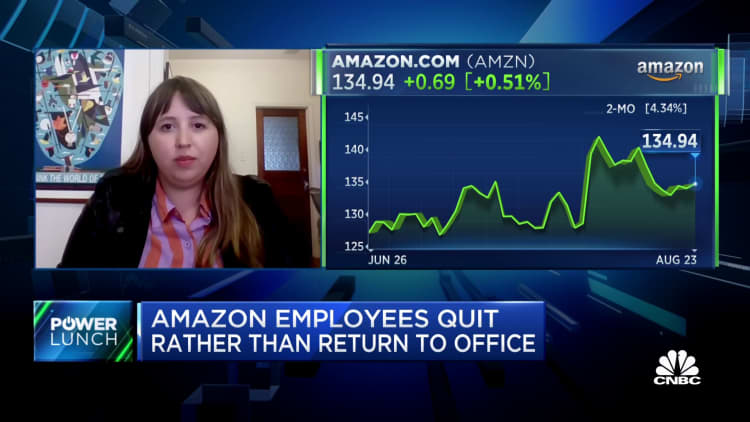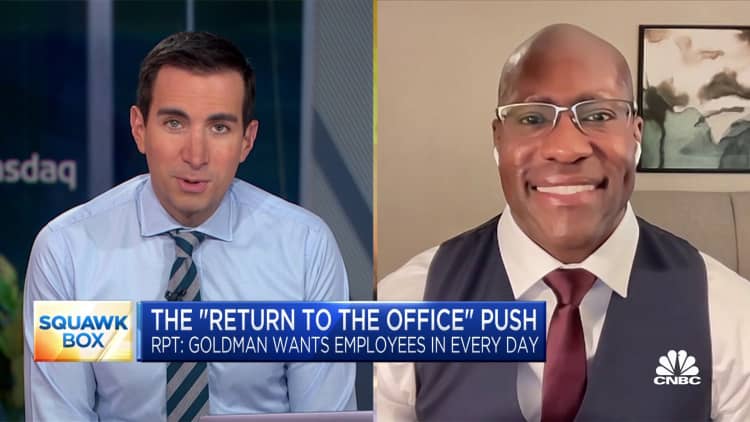The return-to-office debate sees no end in sight as companies grapple with mandates and the employee backlash that follows.
While a whopping 90% of companies plan to implement return-to-office policies by the end of 2024, flexibility remains a top priority for employees — and the lack of it might push them to seek other opportunities.
However, that is exactly what some companies want, according to workplace experts that CNBC Make It spoke to.
“Companies would never come out and say it because of legal implications,” said Dan Schawbel, managing partner at Workplace Intelligence and New York Times bestselling author.
“A company might use a return to office mandate as an opportunity to restructure its workforce.”
Schawbel added that one company that could be employing this “covert layoff” tactic is AT&T, which recently mandated that 60,000 managers across 50 states work in person — but only at offices in just nine locations.
An AT&T employee told Bloomberg in a June report that the telecommunications company’s new return-to-office mandate was “a layoff wolf” in sheep’s clothing.
AT&T did not respond to CNBC Make It’s requests for comment.
RTO is a cheap and dirty way for companies to avoid legal complications and financial obligations associated with layoffs.
Laurie Ruettimann
Career advisor
Making work ‘unappealing’
The need to induce soft layoffs through RTO mandates could be driven by economic threats, recession fears and changes related to consumer spending, workplace experts told CNBC Make It.
“Some companies have been saddled with very pricey real estate as their workforce and often their customers go remote and digital. Companies need to drop some weight any way they can,” said Meghan Biro, a talent management and workplace expert.

This “soft layoff” tactic isn’t new, said Schawbel, and it doesn’t just come in the form of RTO mandates. Here are other ways companies can induce layoffs:
1. Slowing down or halting the hiring process
Allowing natural attrition (employees leaving due to resignations, retirements, or other reasons) to gradually reduce the workforce over time without actively firing employees.
2. Offering voluntary buyouts or early retirement packages to employees
This encourages employees to leave the company on their own terms, while allowing the company to reduce headcount without resorting to involuntary layoffs.
3. Reducing work hours or implementing temporary furlough
This means employees work fewer hours or take unpaid leave for a specific period, helping the company save costs while retaining the workforce.
The goal was to target the quiet quitters and those with opportunities elsewhere by making the current work environment unappealing.
Laurie Ruettimann
Career advisor
Career advisor and workplace expert Laurie Ruettimann agreed, saying that she had to employ the same “soft layoff” tactics in 2001.
“[We were] restructuring reporting responsibilities to make workers less comfortable, or subtly increasing workload or duties for people exempt from overtime,” she added.
“The goal was to target the quiet quitters and those with opportunities elsewhere by making the current work environment unappealing.”
In the same way, RTO mandates can be especially cumbersome — by removing perks such as flexibility, being able to care for others at home as well as saving time and money on commuting.
“Rolling back those gains, such as remote work and flexible hours, is audacious, but companies are daring employees to quit,” Ruettimann added.

Amazon, for example, doubled down on its RTO policy by demanding some staffers move to a central hub. This prompted some employees to leave instead of uprooting their families or breaking their leases.
A RTO mandate also presents an opportunity for some companies to eliminate staff by evaluating individual performance under new circumstances, said Schawbel.
“Employees who are deemed to be less productive or adaptable during this phase could potentially be targeted for layoffs,” he added.
“If a company decides that certain roles must be performed in the office, they might lay off remote workers and then initiate a new hiring process to fill those roles with employees willing to work in the office.”
Why it works for companies — or not
Why wouldn’t companies call a spade a spade? It could be due to a multitude of reasons, but experts told CNBC Make It it ultimately “comes down to money.”
“RTO is a cheap and dirty way for companies to avoid legal complications and financial obligations associated with layoffs,” said Ruettimann.
Some of these obligations include severance packages and unemployment insurance, which companies don’t have to provide if employees decide to leave on their own.
By associating the layoffs with a broader workplace strategy, the company can direct the narrative and manage the way the information is perceived by both employees and the public, said Schawbel.
It’s assumed those unwilling to return to the office may not be as invested in the company’s future, making them more likely to leave voluntarily.
“Announcing direct layoffs can lead to a drop in morale among remaining employees, which could affect productivity and overall workplace atmosphere,” he added.
“By framing the layoffs as part of a larger strategy, the company might attempt to minimize the negative impact on morale. It can also lead to less speculation about the company’s financial health and stability.”
Many leaders and HR professionals believe they can gauge the commitment level of their employees by counting heads and tallying up who comes back to the office, said Ruettimann.
“It’s assumed those unwilling to return to the office may not be as invested in the company’s future, making them more likely to leave voluntarily,” she added.
“But that process is flawed … Many who remain [may not be more invested but] are scared or lack the opportunity to leave.”
Soft layoffs can also backfire by overworking the remaining employees, leading to burnout and reduced productivity.

“Implementing a mandatory RTO policy without considering employees’ well-being and work-life balance can negatively impact morale and overall engagement,” said Schawbel.
“Employees who feel their needs aren’t being considered might become disengaged, which could lead to decreased productivity and innovation.”
Over time, skilled and valuable employees will choose to leave rather than comply with a mandate that doesn’t align with their work preferences.
“I think some companies are using the [RTO] tactic as a way to show they have strength of conviction despite what their employees might prefer,” Biro added.
“But employees are tired of being jacked around by managers and leaders. Many seeking career advice from me prefer to bet on themselves and leave rather than return to an office rooted in an unhealthy power dynamic.”
Don’t miss: Google VP shares the No. 1 thing she looks for in job interviews: ‘This is a critical trait’
Like this story? Subscribe to CNBC Make It on YouTube!

